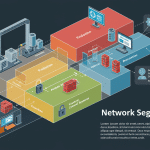
Network Segmentation: Fortifying Manufacturing Against Cyber Threats
April 27, 2025
Secure Skies: Cloud Power for Manufacturing Operations
April 30, 2025Manufacturing Cyberattack? Plan Your Response Now!
When a cyberattack strikes a manufacturing facility, the consequences can ripple far beyond just IT systems. Production lines grind to a halt, supply chains are disrupted, sensitive data is compromised, and the financial and reputational damage can be severe. For small to medium-sized manufacturing businesses, many of which may lack dedicated in-house cybersecurity teams, these threats can feel particularly daunting. However, with proactive incident response planning, you can significantly minimize downtime and navigate the chaos effectively.
Why Manufacturing Facilities Are Prime Targets
Manufacturing facilities are increasingly attractive targets for cybercriminals due to several factors:
- Operational Technology (OT) Convergence:
The growing integration of IT and OT systems, while boosting efficiency, also expands the attack surface. Compromising OT systems can directly impact physical processes and safety.
- Critical Infrastructure:
Manufacturing often forms a crucial part of the supply chain and even critical infrastructure, making disruptions highly impactful.
- Intellectual Property:
Manufacturers often possess valuable intellectual property, including designs, formulas, and processes, making them targets for espionage.
- Lower Cybersecurity Maturity:
Compared to other sectors, some SMB manufacturers may have less mature cybersecurity defenses, presenting easier opportunities for attackers.
The Cornerstones of an Effective Incident Response Plan
An incident response plan (IRP) is a documented set of procedures to follow when a security incident occurs. It’s not just a technical document; it involves people, processes, and technology working in concert. Here are the essential components for a manufacturing facility:
1. Identification and Assessment:
- Establish Clear Reporting Channels: Ensure all employees know how to report suspicious activity or potential security incidents. This might involve a dedicated email address, phone number, or internal platform.
- Develop Detection Mechanisms: Implement robust monitoring tools and security solutions to detect anomalies and potential intrusions in both IT and OT environments. This includes intrusion detection/prevention systems (IDS/IPS), endpoint detection and response (EDR), and security information and event management (SIEM) systems.
- Form an Incident Response Team (IRT): Designate a cross-functional team with representatives from IT, OT, operations, legal, and management. Clearly define roles and responsibilities within the team.
- Conduct Initial Assessment: When an incident is suspected, the IRT must quickly gather information to understand the scope, nature, and potential impact of the attack. This involves analyzing logs, system alerts, and employee reports.
2. Containment:
- Isolate Affected Systems: The priority is to prevent the attack from spreading. This may involve isolating compromised network segments, taking affected machines offline, or shutting down specific OT systems. Careful consideration must be given to the potential impact on production during this phase.
- Secure Evidence: Preserve any logs, files, or system images that might be crucial for later analysis and potential legal proceedings. Follow established forensic procedures.
- Communicate Internally: Keep employees informed about the situation and any necessary steps they need to take. Designate a spokesperson for internal communications.
3. Eradication:
- Identify the Root Cause: Thoroughly investigate the attack to determine how the breach occurred, the attacker’s methods, and any vulnerabilities exploited.
- Remove the Threat: Eliminate the malware, unauthorized access points, or other malicious elements from the affected systems. This may involve cleaning systems, restoring from clean backups, or rebuilding compromised infrastructure.
- Patch Vulnerabilities: Address the underlying security weaknesses that allowed the attack to succeed to prevent future incidents.
4. Recovery:
- Restore Systems and Data: Carefully and systematically restore affected IT and OT systems to their operational state. Prioritize critical production systems to minimize downtime. Ensure data integrity during the recovery process.
- Verify System Integrity: After restoration, thoroughly test all systems to ensure they are functioning correctly and are secure.
- Communicate Externally: Depending on the nature and impact of the attack, you may need to communicate with customers, suppliers, regulatory bodies, and the public. Develop a clear and consistent external communication strategy.
5. Lessons Learned:
- Conduct a Post-Incident Analysis: Once the incident is resolved, the IRT should conduct a thorough review of the entire process. Identify what went well, what could have been done better, and any gaps in the plan or security controls.
- Update the Incident Response Plan: Based on the lessons learned, update the IRP and other security policies and procedures to improve future preparedness.
- Implement Necessary Improvements: Take concrete steps to address identified vulnerabilities and enhance security measures. This might involve investing in new technologies, providing additional training, or refining existing processes.
Minimizing Downtime: A Manufacturing Imperative
For manufacturing facilities, downtime translates directly into lost revenue, missed deadlines, and potential damage to reputation. A well-executed IRP is crucial for minimizing this impact by:
- Speeding up the Response:
A predefined plan allows for swift and coordinated action, reducing the time it takes to contain and eradicate the threat.
- Prioritizing Recovery:
The IRP should outline procedures for prioritizing the restoration of critical production systems.
- Maintaining Communication:
Clear communication minimizes confusion and ensures everyone knows their role, facilitating a faster recovery.
- Preventing Future Incidents:
Learning from past attacks and updating the plan strengthens defenses and reduces the likelihood of future disruptions.
Proactive Preparedness: The Best Defense
While a robust IRP is essential for responding to attacks, proactive preparedness is the first line of defense. This includes:
- Regular Security Assessments:
Identify vulnerabilities in both IT and OT environments through penetration testing and vulnerability scanning.
- Employee Training:
Educate employees about common cyber threats, phishing scams, and safe online practices.
- Strong Security Controls:
Implement and maintain robust security measures, including firewalls, intrusion detection/prevention systems, multi-factor authentication, and regular patching.
- Data Backup and Recovery:
Establish a comprehensive backup and recovery strategy for both IT and OT systems, ensuring the ability to restore critical data quickly.
- OT-Specific Security:
Implement security measures tailored to the unique challenges of OT environments, such as network segmentation and industrial control system (ICS) security protocols.
Don’t wait until an attack disrupts your production. Investing in incident response planning and proactive cybersecurity measures is a critical investment in the resilience and future of your manufacturing business.
Ready to strengthen your cybersecurity posture and develop a tailored incident response plan? Contact Krypto IT today for a free consultation!
Our Houston-based team specializes in protecting small to medium-sized manufacturing businesses like yours.
#IncidentResponse #Cybersecurity #Manufacturing #OTSecurity #Houston #KryptoIT #SMB #CyberAttack




